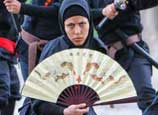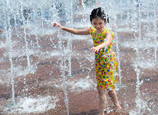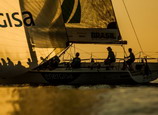
The scenic region has three parts, the Lake Zone, the Plain Zone and the Mountain Zone. The Lake Zone is located to the north of the palace region and features both the grace of China's southern lakes and the roughness of China's northern lakes. The lake group in the zone is generally called the "Sai Lakes" which covers 57 hectares in total. The total area of all the islands is 28 hectares. The Sai Lakes originally contained nine lakes and 10 islands. The nine lakes were the Mirror Lake, Silver Lake, Lower Lake, Upper Lake, Clear Lake, Ruyi Lake, Inner Lake, Long Lake and Half-Moon Lake. The 10 islands consisted of five larger islands and five smaller ones. The larger ones were the Wenyuan Island, Qingshushan Hall Island, Moonlight and River-Sound Island, Ruyi Island and Wenjin Island. The smaller ones were the Jiede Hall Island, Gold Mountain Island, Green Lotus Island, Huanbi Island and Linfang Villa Island. The islands are connected with bridges and currently, only seven of the nine lakes and eight of the 10 islands remain.
The Plain Zone is located to the east of the Lake Zone, covering 53 hectares. It has four pavilions in its southern part along the lakeside named "Flowing Water Floating Cloud," "River Sound," "Forest Bird Twitter" and "Green Meadow." Other scenic spots include the "Duckweed Courtyard," "Spring Scenery Garden," "Waterside Tower," "Thousand-Tree Park," "Royal Race Course," "Yongyou Temple" and "Buddhist Relics Pagoda." According to Mongolian customs, no building was set in the "Thousand-Tree Park" except for several Mongolian tents. The Qianlong Emperor used to give receptions to government and religious leaders of minority nationalities and hold outdoor feasts in this park. To the west and north of the Plain Zone was the Mountain Zone, which covers 422 hectares, 80 percent of the resort's total area. The steep mountains in this zone belong to the Fengyunling Mountain System, a branch of the Yanshan Mountains. From north to south, you can see four great valleys in this zone, the Songyun Valley, Pear Tree Valley, Pine Forest Valley and Filbert Valley. During Kangxi and Qianlong periods, 40 towers, pavilions, temples and halls were built in the mountain, and all of them were connected with footpaths. The high mountain peaks are like natural barriers which block the cold wind from the north and west, and they are an important element that affects the climate of the resort.
In order to religiously win the support of the minority nationalities living in Mongolia, Xinjiang, Tibet and other regions, the Qing Dynasty built 12 temples of various architectural styles around the Mountain Resort. Of them, eight were directly administrated by the Qing Government, and therefore called the Outer Eight Temples. Based on architectural styles, the temples can be divided into Tibetan style temples, Han style temples and Tibetan-Han style temples. These temples all contain the architectural essence of the Han, Tibetan and other nationalities of China, and look really splendid and royal.
Different from other royal resorts, the Mountain Resort inherited and developed China's traditional classic architectural idea of "design based on nature, but making it surpass nature." The site selection and overall design of the resort were all based on the natural landforms and the construction was perfectly integrated with nature. Meanwhile, China's northern and southern architectural essences were also absorbed into the resort. The resort is a brilliant milestone in China's resort construction history and also an excellent work of China's classic resort architecture. It has always been praised as the "Reduction of China's Landforms" and "Top Example of China's Classic Resorts."


















 Wild Siberian tiger kills cattle in NE China
Wild Siberian tiger kills cattle in NE China


![]()
